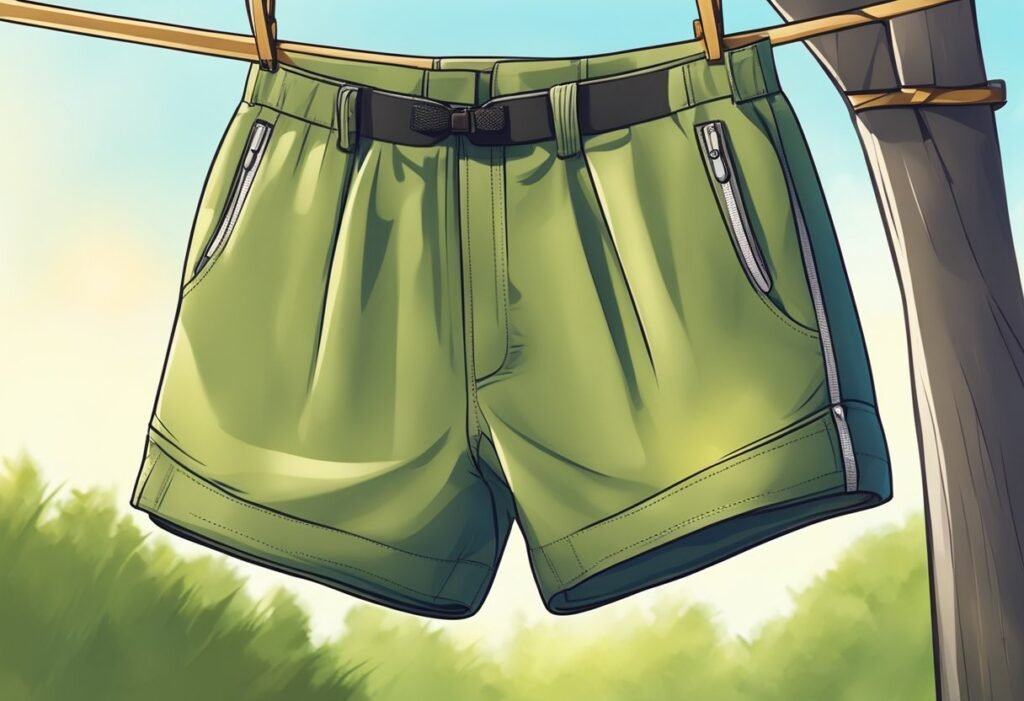Best Materials for Hot Climate Outdoor Shorts
When it comes to outdoor activities in hot climates, having the right clothing can make all the difference. This is especially true for shorts, as they offer a balance of comfort and mobility. However, not all materials are created equal when it comes to outdoor shorts in hot climates. So, what materials are best suited for this purpose?
First and foremost, it’s important to look for materials that are lightweight and breathable. This will help to keep the wearer cool and comfortable, even in high temperatures. Fabrics such as nylon, polyester, and spandex are all good options, as they are lightweight and moisture-wicking, which helps to keep sweat away from the skin.
Another factor to consider is durability. Outdoor activities can be tough on clothing, so it’s important to choose materials that can withstand wear and tear. Look for fabrics that are abrasion-resistant and quick-drying, such as ripstop nylon or polyester blends. These materials are also less likely to shrink or fade in the sun, making them a great choice for outdoor shorts in hot climates.
Characteristics of Outdoor Shorts for Hot Climates
When it comes to selecting outdoor shorts for hot climates, there are several characteristics that are important to consider. These characteristics include breathability, moisture-wicking, durability, and lightweight.
Breathability
Breathability is an important characteristic to consider when selecting outdoor shorts for hot climates. Breathable materials allow air to circulate and keep the body cool. Fabrics such as cotton, linen, and rayon are known for their breathability and are great options for outdoor shorts in hot climates.
Moisture Wicking
Moisture-wicking is another important characteristic to consider when selecting outdoor shorts for hot climates. Moisture-wicking fabrics help to absorb sweat and keep the body dry. Nylon, polyester, and spandex are known for their moisture-wicking properties and are great options for outdoor shorts in hot climates.
Durability
Durability is an important characteristic to consider when selecting outdoor shorts for hot climates. Outdoor activities can be tough on clothing, so it’s important to select shorts that can withstand wear and tear. Materials such as nylon and polyester are known for their durability and are great options for outdoor shorts in hot climates.
Lightweight
Lightweight materials are important to consider when selecting outdoor shorts for hot climates. Heavy materials can weigh a person down and make them feel uncomfortable in hot weather. Materials such as cotton, linen, and nylon are known for their lightweight properties and are great options for outdoor shorts in hot climates.
Popular Materials for Outdoor Shorts
When it comes to choosing the right material for outdoor shorts in hot climates, there are several options to consider. Here are some of the most popular materials used for outdoor shorts:
Cotton Blends
Cotton blends are a popular choice for outdoor shorts due to their breathability and comfort. They are usually made from a combination of cotton and synthetic fibers, which helps to wick away moisture and keep the wearer cool. Cotton blends are also easy to care for and can be machine washed.
Synthetic Fabrics
Synthetic fabrics such as polyester and nylon are also commonly used for outdoor shorts. These materials are lightweight, quick-drying, and durable, making them ideal for outdoor activities. They are also resistant to wrinkles and shrinkage, which makes them easy to care for.
Natural Fibers
Natural fibers such as linen and hemp are also suitable for outdoor shorts in hot climates. These materials are lightweight, breathable, and have natural moisture-wicking properties. They are also environmentally friendly and biodegradable, making them a sustainable choice.
Overall, when choosing the best material for outdoor shorts in hot climates, it is important to consider factors such as breathability, moisture-wicking properties, durability, and ease of care. With the right material, outdoor enthusiasts can stay cool, comfortable, and stylish during their adventures.
Material Treatments and Technologies
UV Protection
One of the most important factors in outdoor shorts for hot climates is UV protection. Exposure to the sun’s harmful rays can cause skin damage and increase the risk of skin cancer. To combat this, many outdoor shorts are made with materials that provide UV protection. Look for shorts that have a UPF (Ultraviolet Protection Factor) rating of 50 or higher, which blocks 98% of UV radiation.
Antimicrobial Treatments
When you’re sweating in hot climates, bacteria can quickly build up on your skin and clothing, causing unpleasant odors. To combat this, some outdoor shorts are treated with antimicrobial agents that prevent the growth of bacteria. This can help keep you feeling fresh and comfortable, even on the hottest days.
Water-Resistant Coatings
If you’re planning on spending time near water, whether it’s a river, lake, or ocean, water-resistant coatings can be a valuable feature in outdoor shorts. These coatings help repel water and prevent the shorts from becoming waterlogged, which can be uncomfortable and lead to chafing. Look for shorts that are treated with a DWR (Durable Water Repellent) coating, which will cause water to bead up and roll off the fabric.
Overall, when choosing outdoor shorts for hot climates, look for materials that are breathable, lightweight, and quick-drying. Additionally, consider features such as UV protection, antimicrobial treatments, and water-resistant coatings to help keep you comfortable and protected during your outdoor adventures.
Environmental Considerations and Sustainability
Eco-Friendly Materials
When it comes to outdoor shorts, choosing eco-friendly materials can greatly reduce the environmental impact. Some of the best eco-friendly materials for hot climates include organic cotton, linen, and hemp. These materials are biodegradable, renewable, and require less water and pesticides than conventional materials.
Organic cotton is grown without the use of harmful chemicals, making it a great choice for those who are concerned about their environmental impact. Linen is also a sustainable material that is made from flax plants, and it is known for its breathability and durability. Hemp is another eco-friendly material that is highly durable, breathable, and resistant to mold and mildew.
Recycled Fabrics
Recycled fabrics are also a great option for outdoor shorts in hot climates. These materials are made from post-consumer waste such as plastic bottles, fishing nets, and other materials that would otherwise end up in landfills or oceans. By using recycled fabrics, you can help reduce the environmental impact of the textile industry.
Some popular recycled fabrics for outdoor shorts include recycled polyester, nylon, and spandex. These materials are lightweight, quick-drying, and moisture-wicking, making them ideal for hot and humid climates. Additionally, recycled fabrics can be just as durable and high-performing as conventional materials, making them a great choice for outdoor enthusiasts who want to reduce their environmental impact.
Overall, choosing eco-friendly and recycled materials for outdoor shorts can help reduce the environmental impact of the textile industry while still providing high-quality and durable clothing for outdoor activities.
Choosing the Right Outdoor Shorts
When it comes to selecting the perfect outdoor shorts for hot climates, there are a few key factors to consider. From fit and comfort to activity-specific features, the right shorts can make all the difference in keeping you cool and comfortable during your outdoor adventures. Here are some key aspects to keep in mind:
Fit and Comfort
One of the most important considerations when choosing outdoor shorts is the fit and comfort level. Look for shorts that fit well and allow for easy movement, without being too tight or restrictive. Many outdoor shorts come with adjustable waistbands or drawstrings, which can help ensure a comfortable fit for a range of body types.
In terms of materials, lightweight and breathable fabrics such as nylon, polyester, and spandex are ideal for hot climates. These materials are quick-drying and moisture-wicking, which can help keep you cool and dry even in the hottest conditions.
Activity-Specific Features
Depending on the specific activities you have planned, you may want to look for shorts with certain features that can enhance your performance and comfort. For example, if you’ll be hiking or climbing, look for shorts with reinforced seams or stretchy panels that can withstand wear and tear. If you’ll be spending time near water, consider shorts with built-in UPF protection or water-resistant coatings.
Some other activity-specific features to look for include pockets for storing essentials, ventilation panels for added breathability, and reflective detailing for increased visibility during low-light conditions.
Style and Versatility
While fit and function are certainly important, you’ll also want to consider the style and versatility of your outdoor shorts. Look for shorts that can easily transition from outdoor adventures to everyday wear, with classic colors and designs that can be dressed up or down as needed.
In terms of length, many outdoor enthusiasts prefer shorts that fall just above the knee, as this length provides ample coverage without impeding movement. However, the right length will ultimately depend on your personal preference and the specific activities you have planned.
Overall, choosing the right outdoor shorts for hot climates requires careful consideration of fit, function, and style. By keeping these key factors in mind, you can find the perfect pair of shorts to keep you cool, comfortable, and stylish during all your outdoor adventures.

